This collection of biographies, which have garnered honors in 2015, offers engaging and stimulating reading in a range of formats and topics. The biographies give insight into the lives of famous people and their legacies. These reviews identify the honors each book received.
Ages 4–8
Swan: The Life and Dance of Anna Pavlova. Laurel Snyder. Ill. Julie Morstad. Chronicle.
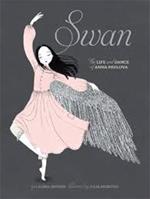 A visit to the ballet one snowy night changes the life of a young girl. “Now Anna cannot sleep. Or sit still ever. She can only sway, dip, and spin… .” Two years later, Anna begins formal ballet training. After five years of hard work, she steps alone onto the stage as the swan. She travels the world, bringing the beauty of ballet to everyone until she falls ill. On her deathbed, Anna calls for her feathered swan dress. Snyder’s spare, lyrical text and Mortstad’s exquisite mixed-media artwork beautifully convey the life story of Anna Pavlova (1881–1931). An author’s note offers more information on the Russian dancer who is recognized widely as the greatest ballerina of all time. 2016 Orbis Pictus Honorable Mention.
A visit to the ballet one snowy night changes the life of a young girl. “Now Anna cannot sleep. Or sit still ever. She can only sway, dip, and spin… .” Two years later, Anna begins formal ballet training. After five years of hard work, she steps alone onto the stage as the swan. She travels the world, bringing the beauty of ballet to everyone until she falls ill. On her deathbed, Anna calls for her feathered swan dress. Snyder’s spare, lyrical text and Mortstad’s exquisite mixed-media artwork beautifully convey the life story of Anna Pavlova (1881–1931). An author’s note offers more information on the Russian dancer who is recognized widely as the greatest ballerina of all time. 2016 Orbis Pictus Honorable Mention.
—CA
W Is for Webster: Noah Webster and His American Dictionary. Tracey Fern. Ill. Boris Kulikov. 2015. Margaret Ferguson Books/Farrar Straus Giroux.
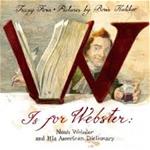 For Noah Webster, a farm boy with little schooling, nothing was more important than learning and language so, in 1774, his father took out a loan on the farm and sent 16-year-old Noah to study at Yale. Noah immersed himself in words. Becoming a teacher in the newly independent American colonies, he believed that a “national language is a national tie” and created his first speller in 1789. After publishing a small dictionary in 1806, he was determined to write the definitive dictionary of English in America. Lively and humorous mixed-media illustrations show how Webster dedicated his efforts over two decades, in the face of public ridicule and during years in which he and his wife, Rebecca Greenleaf, raised their eight children, to writing An American Dictionary of the English Language, the largest English dictionary ever written. 2016 Orbis Pictus Recommended Book.
For Noah Webster, a farm boy with little schooling, nothing was more important than learning and language so, in 1774, his father took out a loan on the farm and sent 16-year-old Noah to study at Yale. Noah immersed himself in words. Becoming a teacher in the newly independent American colonies, he believed that a “national language is a national tie” and created his first speller in 1789. After publishing a small dictionary in 1806, he was determined to write the definitive dictionary of English in America. Lively and humorous mixed-media illustrations show how Webster dedicated his efforts over two decades, in the face of public ridicule and during years in which he and his wife, Rebecca Greenleaf, raised their eight children, to writing An American Dictionary of the English Language, the largest English dictionary ever written. 2016 Orbis Pictus Recommended Book.
—SW
Ages 9–11
Ada Byron Lovelace and the Thinking Machine. Laurie Wallmark. Ill. April Chu. 2015. Creston.
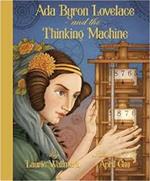 From an early age, Ada Byron Lovelace (1815–1852) loved numbers. They became her friends in equations and inventions she developed during the long absences of her mother, who had left her father, the poet Lord Byron, when Ada was a baby. Ada longed to build a flying machine and experimented with the effects of wind on the sails of a toy boat. At the age of 17, she began working with mathematician Charles Babbage, who designed a mechanical computer, his Analytical Engine, but had not built it. Recognizing that the computer would need instructions to solve complex math problems, Ada created an algorithm for the Analytical Engine. In doing so, she also created a new profession, computer programming. An author’s note includes information on Ada Byron Lovelace’s lifelong interest in math and science and Ada’s software, the world’s first computer program. 2016 NSTA Outstanding Science Trade Book.
From an early age, Ada Byron Lovelace (1815–1852) loved numbers. They became her friends in equations and inventions she developed during the long absences of her mother, who had left her father, the poet Lord Byron, when Ada was a baby. Ada longed to build a flying machine and experimented with the effects of wind on the sails of a toy boat. At the age of 17, she began working with mathematician Charles Babbage, who designed a mechanical computer, his Analytical Engine, but had not built it. Recognizing that the computer would need instructions to solve complex math problems, Ada created an algorithm for the Analytical Engine. In doing so, she also created a new profession, computer programming. An author’s note includes information on Ada Byron Lovelace’s lifelong interest in math and science and Ada’s software, the world’s first computer program. 2016 NSTA Outstanding Science Trade Book.
—SW
Game Changer: John McLendon and the Secret Game. John Coy. Ill. Randy DuBurke. 2015. Carolrhoda Books/Lerner.
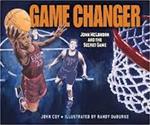 In 1944, five basketball players on the Duke University Medical School team set out to play a secret game with the starting lineup of the North Carolina College for Negroes team, coached by John McLendon, who learned the sport from James Naismith. Although the players were apprehensive and awkward at its beginning, the game picked up. The illustrations, rendered in paint and graphite, depict the fast-paced game the African American team generated as they demonstrated moves not seen by white teams before and that became the standard of the game. The game remained secret for decades because the Ku Klux Klan considered “mixing the races” a crime punishable by death. The author’s note includes additional information on Coach McLendon’s life and work. 2016 Orbis Pictus Recommended Book.
In 1944, five basketball players on the Duke University Medical School team set out to play a secret game with the starting lineup of the North Carolina College for Negroes team, coached by John McLendon, who learned the sport from James Naismith. Although the players were apprehensive and awkward at its beginning, the game picked up. The illustrations, rendered in paint and graphite, depict the fast-paced game the African American team generated as they demonstrated moves not seen by white teams before and that became the standard of the game. The game remained secret for decades because the Ku Klux Klan considered “mixing the races” a crime punishable by death. The author’s note includes additional information on Coach McLendon’s life and work. 2016 Orbis Pictus Recommended Book.
—SW
My Story, My Dance: Robert Battle’s Journey to Alvin Ailey. Lesa Cline-Ransome. Ill. James E. Ransome. 2015. Paula Wiseman Books/Simon & Schuster.
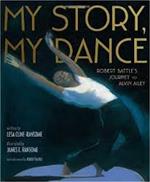 Movement and dance were as natural as breathing to 6-year-old Robert after the removal of braces worn to straighten his bowlegs. Raised by his aunt, uncle, and cousin, he loved the music of his home life and grew in confidence through singing at the AME Church. Dance was the center of his life; he began ballet lessons at the age of 13 and then won a scholarship to Juilliard. James E. Ransome’s pastel illustrations show Battle’s expansive, expressive dance style as a student and later as a professional dancer before becoming the artistic director of the Alvin Ailey American Dance Company in 2011. Robert Battle provides an inspiring foreword. Back matter includes author’s and illustrator’s notes; a bibliography of articles and video, radio, and Internet resources; and suggestions for further reading. 2016 Orbis Pictus Recommended Book.
Movement and dance were as natural as breathing to 6-year-old Robert after the removal of braces worn to straighten his bowlegs. Raised by his aunt, uncle, and cousin, he loved the music of his home life and grew in confidence through singing at the AME Church. Dance was the center of his life; he began ballet lessons at the age of 13 and then won a scholarship to Juilliard. James E. Ransome’s pastel illustrations show Battle’s expansive, expressive dance style as a student and later as a professional dancer before becoming the artistic director of the Alvin Ailey American Dance Company in 2011. Robert Battle provides an inspiring foreword. Back matter includes author’s and illustrator’s notes; a bibliography of articles and video, radio, and Internet resources; and suggestions for further reading. 2016 Orbis Pictus Recommended Book.
—SW
Ages 12–14
Enchanted Air: Two Cultures, Two Wings: A Memoir. Margarita Engle. 2015. Atheneum/Simon & Schuster.
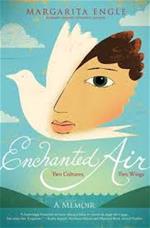 In a series of beautifully crafted poems, Margarita Engle, the daughter of a Cuban mother and an American father, tells of her love of the two worlds to which she belonged as a child: the tropical island world of her mother’s family, with its warm acceptance of her on summer visits, and the busy world of Los Angeles, where her family lives the rest of the year and she attends school with children who are not friendly. Engle recalls the disturbing upheaval of her young life as conflict between Cuba and the United States escalates during the Cold War era and the United States bans travel to Cuba. The last poem expresses the hope Margarita, at the age of 14, has for the future. “Someday, surely I’ll be free / to return to the island of all my childhood / dreams” (p. 185). The author’s note brings the reader up to date. 2016 YALSA Excellence in Nonfiction Award Finalist; 2016 Pura Belpré Award.
In a series of beautifully crafted poems, Margarita Engle, the daughter of a Cuban mother and an American father, tells of her love of the two worlds to which she belonged as a child: the tropical island world of her mother’s family, with its warm acceptance of her on summer visits, and the busy world of Los Angeles, where her family lives the rest of the year and she attends school with children who are not friendly. Engle recalls the disturbing upheaval of her young life as conflict between Cuba and the United States escalates during the Cold War era and the United States bans travel to Cuba. The last poem expresses the hope Margarita, at the age of 14, has for the future. “Someday, surely I’ll be free / to return to the island of all my childhood / dreams” (p. 185). The author’s note brings the reader up to date. 2016 YALSA Excellence in Nonfiction Award Finalist; 2016 Pura Belpré Award.
—CA
Steve Jobs: Insanely Great. Jessie Hartland. 2015. Schwartz & Wade/Random House.
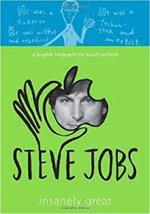 With black-and-white, hand-lettered cartoon panels, Hartland creates a graphic biography of Steve Jobs (1955–2011), the creative genius and entrepreneur who, at 21 years old, started Apple Computer in his family’s garage with Stephen (Woz) Wozniak. After leaving the company, Jobs took on the leadership of Pixar, a computer graphics company, and turned it into a major animation studio. In 1997, Jobs returned to the now-struggling company he had founded and, guided by his insistence that “our job is to figure out what the consumer is going to want before they do,” led the development of Apple into the giant of the personal technology industry it is today. In chronicling the life and work of Steve Jobs, Hartland also provides readers with a decade-by-decade history from “Technology in the 1960s” with rotary-dial phones with cords and typewriters in the 1960s to “What’s New?” in the 21st century with mobile phones spread worldwide, global positioning systems, and the iCloud. 2016 NSTA Outstanding Science Trade Book.
With black-and-white, hand-lettered cartoon panels, Hartland creates a graphic biography of Steve Jobs (1955–2011), the creative genius and entrepreneur who, at 21 years old, started Apple Computer in his family’s garage with Stephen (Woz) Wozniak. After leaving the company, Jobs took on the leadership of Pixar, a computer graphics company, and turned it into a major animation studio. In 1997, Jobs returned to the now-struggling company he had founded and, guided by his insistence that “our job is to figure out what the consumer is going to want before they do,” led the development of Apple into the giant of the personal technology industry it is today. In chronicling the life and work of Steve Jobs, Hartland also provides readers with a decade-by-decade history from “Technology in the 1960s” with rotary-dial phones with cords and typewriters in the 1960s to “What’s New?” in the 21st century with mobile phones spread worldwide, global positioning systems, and the iCloud. 2016 NSTA Outstanding Science Trade Book.
—CA
This Strange Wilderness: The Life and Art of John James Audubon. Nancy Plain. 2015. University of Nebraska Press.
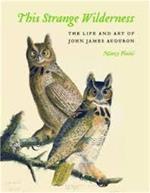 John James Audubon (1785–1851) is best known for his The Birds of America, with its life-size paintings of almost 500 North American bird species posed naturally against backgrounds of their habitats. Plain’s engaging biography reads like a great adventure story. Her well-crafted text, peppered with quotes from Audubon, presents Audubon as an early 19th-century artist, writer, naturalist, hunter, and explorer who clearly deserves his recognition as the founder of modern ornithology. The inclusion of numerous color plates of Audubon’s wildlife paintings and an appendix that includes a glossary, source notes, a bibliography, and an index makes This Strange Wilderness a splendid introduction to Audubon’s life and art. 2016 YALSA Excellence in Nonfiction Award Finalist.
John James Audubon (1785–1851) is best known for his The Birds of America, with its life-size paintings of almost 500 North American bird species posed naturally against backgrounds of their habitats. Plain’s engaging biography reads like a great adventure story. Her well-crafted text, peppered with quotes from Audubon, presents Audubon as an early 19th-century artist, writer, naturalist, hunter, and explorer who clearly deserves his recognition as the founder of modern ornithology. The inclusion of numerous color plates of Audubon’s wildlife paintings and an appendix that includes a glossary, source notes, a bibliography, and an index makes This Strange Wilderness a splendid introduction to Audubon’s life and art. 2016 YALSA Excellence in Nonfiction Award Finalist.
—CA
Ages 15+
Most Dangerous: Daniel Ellsberg and the Secret History of the Vietnam War.Steve Sheinkin. 2015. Roaring Brook.
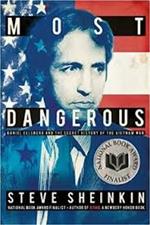 Sheinkin’s account of the personal and public life of Daniel Ellsberg covers the decade from 1964 and the Gulf of Tonkin Resolution, which gave the President of the United States authority to escalate military action in Southeast Asia, to the resignation of President Richard Nixon in 1973. It looks into this tumultuous period and the actions of four Presidents related to Southeast Asia, military forces and war, the Federal courts, American newspapers, and top-secret documents. As an advisor to the State Department, Ellsberg went to South Vietnam to observe the war firsthand for two years. He gradually came to believe that a top-secret study of American policy in Vietnam needed to be made public. He leaked the document, which became known as the Pentagon Papers, to the press in 1971. Was he a hero or a traitor? In his author’s note, Sheinkin details his research. The book, illustrated with archival photographs, opens with a cast of characters and includes source notes, references, an index, and a map. 2016 Orbis Pictus Recommended Book; 2016 YALSA Excellence in Nonfiction Award.
Sheinkin’s account of the personal and public life of Daniel Ellsberg covers the decade from 1964 and the Gulf of Tonkin Resolution, which gave the President of the United States authority to escalate military action in Southeast Asia, to the resignation of President Richard Nixon in 1973. It looks into this tumultuous period and the actions of four Presidents related to Southeast Asia, military forces and war, the Federal courts, American newspapers, and top-secret documents. As an advisor to the State Department, Ellsberg went to South Vietnam to observe the war firsthand for two years. He gradually came to believe that a top-secret study of American policy in Vietnam needed to be made public. He leaked the document, which became known as the Pentagon Papers, to the press in 1971. Was he a hero or a traitor? In his author’s note, Sheinkin details his research. The book, illustrated with archival photographs, opens with a cast of characters and includes source notes, references, an index, and a map. 2016 Orbis Pictus Recommended Book; 2016 YALSA Excellence in Nonfiction Award.
—SW
Sandip Wilson serves as associate professor in the College of Health and Education of Husson University in Bangor, ME. Carolyn Angus is former director of the George G. Stone Center for Children's Books, Claremont Graduate University, CA.
These reviews are submitted by members of the International Reading Association's Children's Literature and Reading Special Interest Group (CL/R SIG) and are published weekly on Literacy Daily.